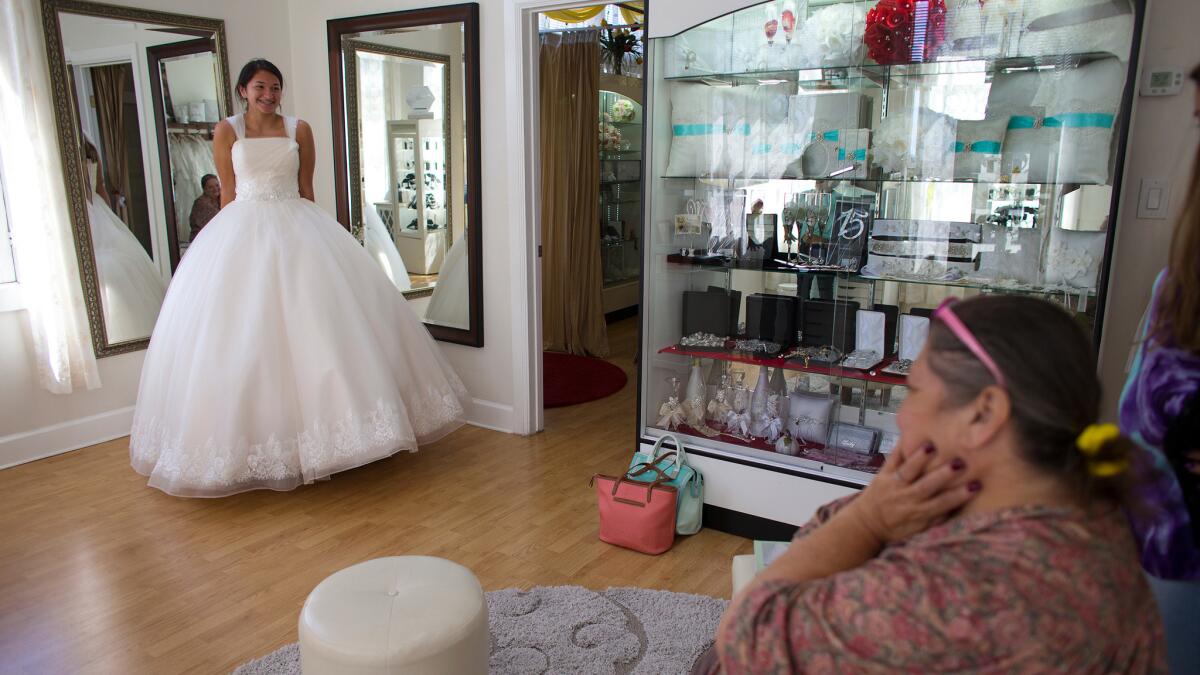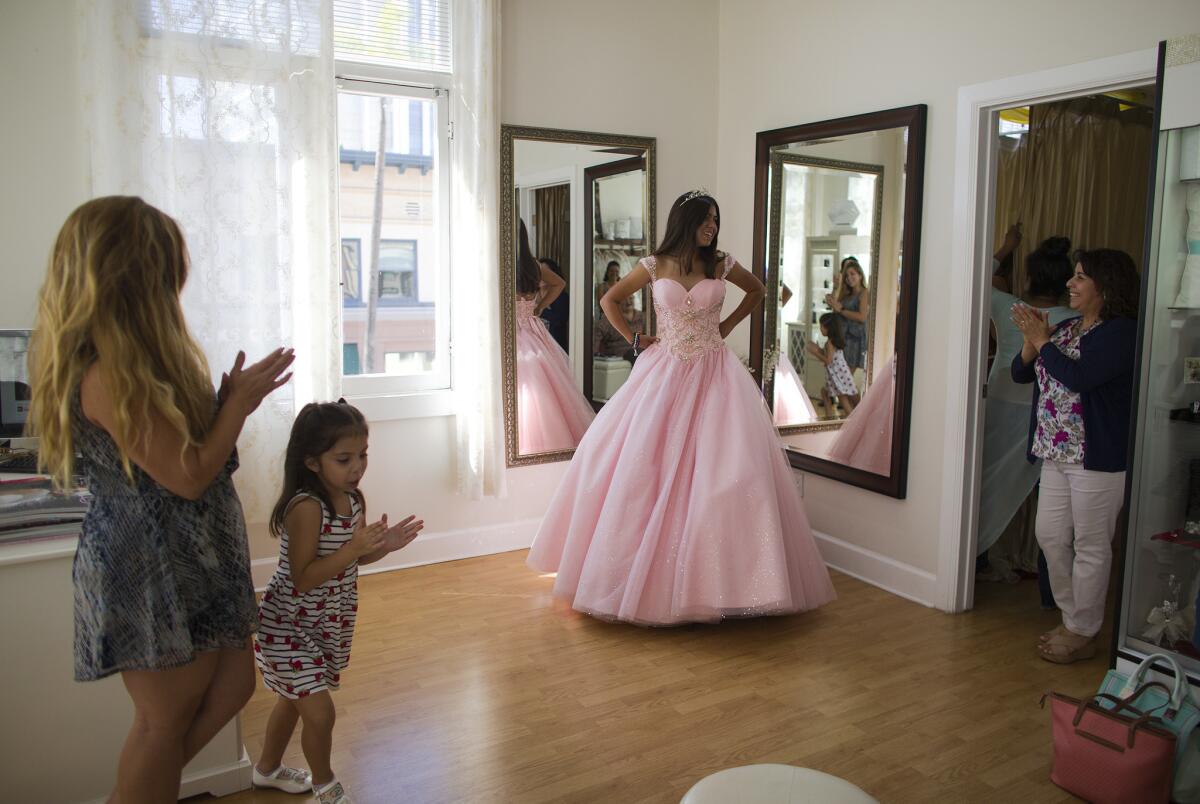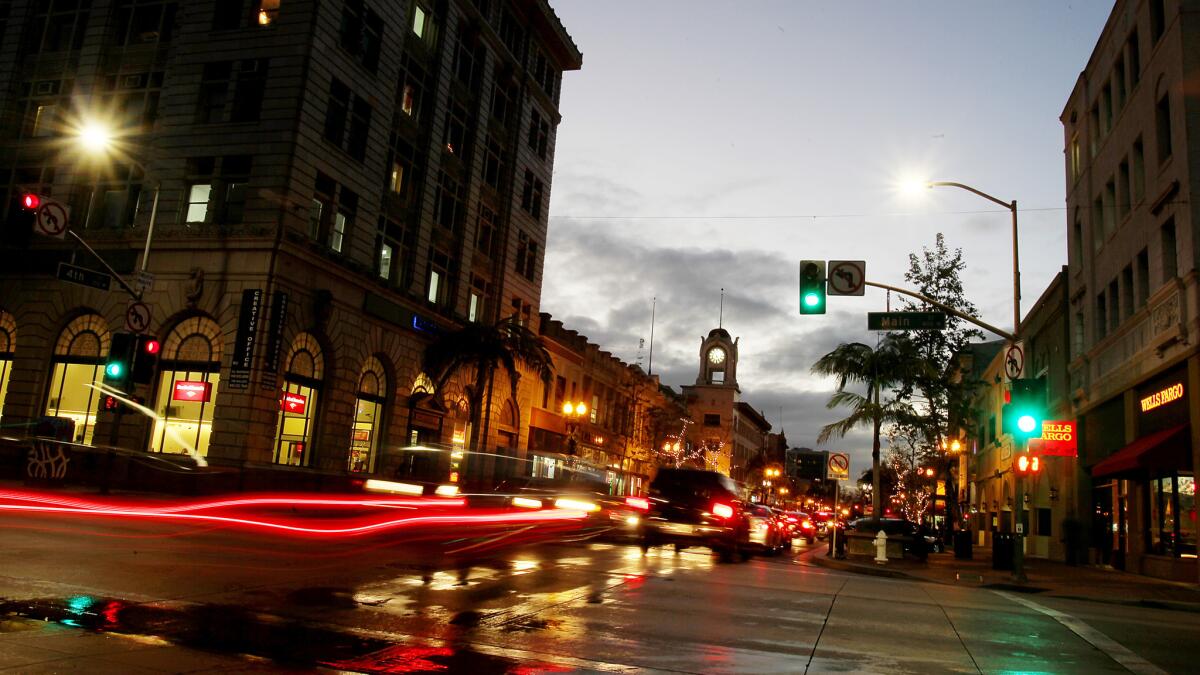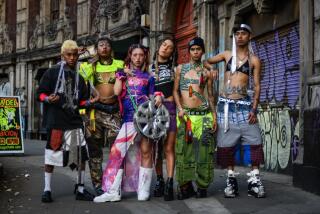In downtown Santa Ana, some Latino merchants try to surf wave of gentrification

- Share via
Quinceañera dresses besieged with organza ruffles no longer take center stage at Genesis Bridal Boutique on downtown Santa Ana’s “Calle Cuatro.”
The brightly colored ball gowns that have swaddled countless girls on their 15th birthday celebration have been relegated to the back of the shop.
Customers who walk into the store’s downtown showroom are now greeted by a white, strapless wedding dress. Behind it, bridesmaid dresses line up in tow, featuring clean lines, few frills, and subdued hues of mauve, lilac and sea green instead of fuchsia or metallic blue.
What seems a mere sartorial tweak in this little corner of Orange County’s Mexican immigrant community is shop owner Lilia Cerpas’ strategic stab at appealing to the neighborhood’s new arrivals: younger, more affluent -- and most likely to be white.
“The newer clients … the Americans and younger generation Hispanics are more selective,” Cerpas, 53, said in Spanish. “They don’t want as many ruffles in their dresses.”
On this front in the never-ending battle over gentrification, some merchants and activists have fought back, refusing to buckle to the wave of change. Others, like Cerpas, have decided to hew to the old maxim: If you can’t beat them, join them. Sort of.
For generations, Santa Ana’s downtown has been a marketplace for primarily Spanish-speaking immigrants — many of them new arrivals from Mexico who came to shop for the kinds of goods and services they could find in their homeland. As on Broadway in downtown Los Angeles, it was businesses catering to Latino immigrants that kept 4th Street financially viable after the white population left decades before.
But since the Great Recession hit, many of these businesses have struggled to stay open. The clientele they had long catered to, already living on meager means, struggled to pay rent and put food on the table. Some returned to Mexico.
“Our world changed in 2008,” said Claudia Arellanes, who owns Mega Furniture with her husband, Arturo Arellanes. “It used to be a gold mine for Latino businesses, and then the recession hit. The undocumented populations lessened. We no longer have much of that clientele.”

A few years ago, the couple moved the heavy and dark-mahogany sofas with tapestry-like upholstery popular with many Latino immigrant arrivals to the back of the store. Now, red sofa chairs a la “Mad Men” take the spotlight at the front of the showroom.
“We modernized ourselves, and I think that’s a good thing,” Arellanes said. “Nobody is displacing me. I displace myself if I don’t adapt. One has to adapt to change in order to survive.”
She said many of her customers are second- and third-generation Latinos who have different tastes from their parents and grandparents.
“The high school girl that graduated this year is not going to try to find the same style dress her grandmother wore, no?” Arellanes said.
But community organizers argue that outsiders, in coordination with city officials, are systematically attempting to erase an immigrant enclave in a city that is almost 80% Latino by bringing in gourmet restaurants and hipster shops and pricing longtime residents out.
“Change may be normal, in a general sense, but gentrification is not. Gentrification is often a process that involves private-public partnerships. In Santa Ana, this is the case. Change was engineered,” said Erualdo Gonzalez, an associate professor of Chicano studies at Cal State Fullerton who studies gentrification in Santa Ana.
This wave of new restaurants and shops in what is now called the East End in downtown Santa Ana is just the latest incarnation of public and private partnerships that lead to gentrification, he said.
Walter Ayala, who has operated the Holiday Travel agency for 22 years on 4th Street, said he wouldn’t know where to begin to cater to newcomers.
“The Americans aren’t interested in coming in. They book their tickets online. It’s the older Latinos who still buy from travel agencies because they want that security and customer attention that I can provide,” he said.
But even those customers don’t show up like they used to, he said, pointing to an empty row of gray chairs on a weekday afternoon. Then there’s the cost of parking in downtown, which just keeps going up, Ayala said, making it less affordable for many of the people who used to patronize his business.
“This used to be all full during the week, and forget about the weekends. It was packed and that was three or four years ago. I used to have three other employees. Now it’s just me,” he said.
Some of his clients would stop by after visiting a swap meet that used to be just a few blocks away. That has been replaced with 4th Street Market, touted as a “progressive culinary hub” that’s popular with hipsters.

Teresa Saldivar has owned Teresa’s Jewelers on the west end of 4th Street for 30 years. While the majority of her customers remain Latino, she said, more Asian, white and younger people are walking through her doors than before. Saldivar said that it’s partly because she started selling jewelry made out of metals other than yellow gold.
When she made the shift, around the time of the recession, she was warned by another jewelry shop owner: “You’re making a big mistake. Latinos will never buy platinum.”
That other shop owner went out of business, Saldivar said.
City Councilwoman Michele Martinez, who represents the 4th Street area of Santa Ana, said the idea of a Latino exodus downtown is exaggerated and that businesses are “appealing to a newer generation of Latinos.”
“You’re seeing some shops transitioning to upscale Latinos and younger generations who like the name brands and are different from their parents,” she said. “They are going out and spending money on food, restaurants downtown and entertainment.”
Cerpas, owner of Genesis Bridal, said she saw change bearing down in 2012 after Playground, an acclaimed modern gastropub, opened in Santa Ana. Tired of contending with a rundown building with a leaky roof and cramped quarters, she dipped into her savings two years ago and took out a loan. She found a new shop and added the word “boutique” to her shop’s name.
She and her husband installed recessed lighting, wood flooring, an elegant chandelier, long wood-framed mirrors and a velvet-tufted sofa. The space is light and airy and the racks are sparse enough to better appreciate the gowns, said Cerpas, who said was inspired by “fancy shops” in Newport Beach.

After her move, Lilia Cerpas said she lost most of her clients, but she’s hopeful she’ll recover many of them over time. Meanwhile, she said she’s made new customers because of the changes she has made.
Still, people tell her that immigrants will be too intimidated to step into her shop because it looks too upscale.
“I really wanted to change the image of the shop. I don’t want to be like the other quinceañera shops on 4th Street. There are many who are resistant to change,” she said. “The thing is that to change you really need to work hard.”
After a beat, she added: “It also takes some money.”
That is something her sister, Vicky Cerpas, has been struggling with. Her own quinceañera shop features old carpeting and weathered pictures of children along with a rendition of the Virgin of Guadalupe. Plastic yard furniture and a round table with dog-eared catalogs of frilly and bright dresses welcome customers.
Vicky Cerpas said she used to employ five women. Now she works alone. The recession and a costly divorce have made it hard to pay the rent, she said.
“It’s been hard for me to adapt,” she said. “I don’t have the money.”
Follow Cindy Carcamo on Twitter @thecindycarcamo
To read the article in Spanish, click here
ALSO
‘I have a corner of my own’: Santa Ana’s bus terminal-turned-shelter offers the homeless some relief
Southland’s major water agency is rebuilding depleted regional storage
A scene of homeless misery greets patrons trying to use Santa Ana’s award-winning library
More to Read
Sign up for Essential California
The most important California stories and recommendations in your inbox every morning.
You may occasionally receive promotional content from the Los Angeles Times.










